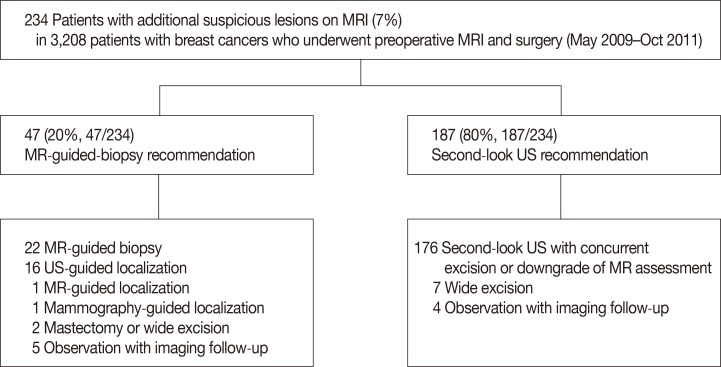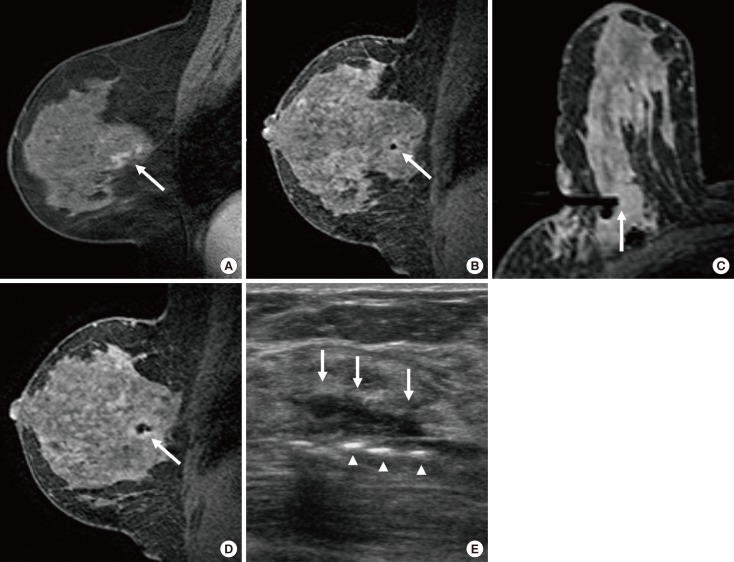J Breast Cancer.
2014 Sep;17(3):270-278. 10.4048/jbc.2014.17.3.270.
Initial Experience with Magnetic Resonance-Guided Vacuum-Assisted Biopsy in Korean Women with Breast Cancer
- Affiliations
-
- 1Department of Radiology, Samsung Medical Center, Sungkyunkwan University School of Medicine, Seoul, Korea. bkhan@skku.edu
- KMID: 2286355
- DOI: http://doi.org/10.4048/jbc.2014.17.3.270
Abstract
- PURPOSE
The aim of this study is to describe our initial experience with magnetic resonance (MR)-guided biopsy and to determine the malignancy rate of additional lesions identified by MR only in Korean women with breast cancer.
METHODS
A retrospective review identified 22 consecutive patients with breast cancer who had undergone MR-guided vacuum-assisted biopsies (VAB) of MR-only identified lesions from May 2009 to October 2011.We evaluated the rate of compliance, the technical success for MR-guided VAB and the MR imaging findings of the target lesions. VAB histology was compared with surgical histology and follow-up imaging findings.
RESULTS
The biopsy recommendations for MR-only identified lesions were accepted in 46.8% (22/47) of patients. One of 22 procedures failed due to the target's posterior location. Among 21 MR-guided VAB procedures, the target lesions were considered as a mass in 12 cases and a nonmass enhancement in nine cases. VAB histology revealed malignancies in 14% (3/21) of cases, high-risk lesions in 24% (5/21) and benign lesions in 62% (13/21). Eleven cases (52%, 11/21) had a positive surgical correlation, and one of them was upgraded from atypical ductal hyperplasia to invasive ductal carcinoma. In the remaining 10 lesions, follow-up breast ultrasound and mammography were available (range, 15-44 months; mean, 32.1 months) and did not show suspicious lesions. The final malignancy rate was 19% (4/21).
CONCLUSION
MR-guided VAB for MR-only identified lesions yielded a 19% malignancy rate in Korean women with breast cancer. MR-guided VAB helps surgeons avoid an unnecessary wide excision or additional excisional biopsy.
MeSH Terms
Figure
Reference
-
1. Baum F, Fischer U, Vosshenrich R, Grabbe E. Classification of hypervascularized lesions in CE MR imaging of the breast. Eur Radiol. 2002; 12:1087–1092. PMID: 11976850.
Article2. Helbich TH. Contrast-enhanced magnetic resonance imaging of the breast. Eur J Radiol. 2000; 34:208–219. PMID: 10927162.
Article3. Peters NH, Borel Rinkes IH, Zuithoff NP, Mali WP, Moons KG, Peeters PH. Meta-analysis of MR imaging in the diagnosis of breast lesions. Radiology. 2008; 246:116–124. PMID: 18024435.
Article4. Fischer U, Kopka L, Grabbe E. Breast carcinoma: effect of preoperative contrast-enhanced MR imaging on the therapeutic approach. Radiology. 1999; 213:881–888. PMID: 10580970.
Article5. Orel SG, Schnall MD. MR imaging of the breast for the detection, diagnosis, and staging of breast cancer. Radiology. 2001; 220:13–30. PMID: 11425968.
Article6. Kuhl CK, Bieling HB, Gieseke J, Kreft BP, Sommer T, Lutterbey G, et al. Healthy premenopausal breast parenchyma in dynamic contrast-enhanced MR imaging of the breast: normal contrast medium enhancement and cyclical-phase dependency. Radiology. 1997; 203:137–144. PMID: 9122382.
Article7. Kuhl CK, Mielcareck P, Klaschik S, Leutner C, Wardelmann E, Gieseke J, et al. Dynamic breast MR imaging: are signal intensity time course data useful for differential diagnosis of enhancing lesions? Radiology. 1999; 211:101–110. PMID: 10189459.
Article8. Orel SG. Differentiating benign from malignant enhancing lesions identified at MR imaging of the breast: are time-signal intensity curves an accurate predictor? Radiology. 1999; 211:5–7. PMID: 10189447.
Article9. Nunes LW, Schnall MD, Orel SG. Update of breast MR imaging architectural interpretation model. Radiology. 2001; 219:484–494. PMID: 11323476.
Article10. Kuhl CK, Schmutzler RK, Leutner CC, Kempe A, Wardelmann E, Hocke A, et al. Breast MR imaging screening in 192 women proved or suspected to be carriers of a breast cancer susceptibility gene: preliminary results. Radiology. 2000; 215:267–279. PMID: 10751498.
Article11. Brown J, Smith RC, Lee CH. Incidental enhancing lesions found on MR imaging of the breast. AJR Am J Roentgenol. 2001; 176:1249–1254. PMID: 11312189.
Article12. Teifke A, Lehr HA, Vomweg TW, Hlawatsch A, Thelen M. Outcome analysis and rational management of enhancing lesions incidentally detected on contrast-enhanced MRI of the breast. AJR Am J Roentgenol. 2003; 181:655–662. PMID: 12933456.
Article13. Liberman L, Morris EA, Dershaw DD, Thornton CM, Van Zee KJ, Tan LK. Fast MRI-guided vacuum-assisted breast biopsy: initial experience. AJR Am J Roentgenol. 2003; 181:1283–1293. PMID: 14573421.14. Orel SG, Rosen M, Mies C, Schnall MD. MR imaging-guided 9-gauge vacuum-assisted core-needle breast biopsy: initial experience. Radiology. 2006; 238:54–61. PMID: 16304093.
Article15. Perlet C, Heywang-Kobrunner SH, Heinig A, Sittek H, Casselman J, Anderson I, et al. Magnetic resonance-guided, vacuum-assisted breast biopsy: results from a European multicenter study of 538 lesions. Cancer. 2006; 106:982–990. PMID: 16456807.16. Choi HY, Kim SM, Jang M, Yun BL, Kim SW, Kang E, et al. MRI-guided intervention for breast lesions using the freehand technique in a 3.0-T closed-bore MRI scanner: feasibility and initial results. Korean J Radiol. 2013; 14:171–178. PMID: 23482868.
Article17. LaTrenta LR, Menell JH, Morris EA, Abramson AF, Dershaw DD, Liberman L. Breast lesions detected with MR imaging: utility and histopathologic importance of identification with US. Radiology. 2003; 227:856–861. PMID: 12773685.
Article18. Liberman L, Morris EA, Lee MJ, Kaplan JB, LaTrenta LR, Menell JH, et al. Breast lesions detected on MR imaging: features and positive predictive value. AJR Am J Roentgenol. 2002; 179:171–178. PMID: 12076929.
Article19. Liberman L, Menell JH. Breast imaging reporting and data system (BI-RADS). Radiol Clin North Am. 2002; 40:409–430. PMID: 12117184.
Article20. Malhaire C, El Khoury C, Thibault F, Athanasiou A, Petrow P, Ollivier L, et al. Vacuum-assisted biopsies under MR guidance: results of 72 procedures. Eur Radiol. 2010; 20:1554–1562. PMID: 20119729.
Article21. Liberman L, Bracero N, Morris E, Thornton C, Dershaw DD. MRI-guided 9-gauge vacuum-assisted breast biopsy: initial clinical experience. AJR Am J Roentgenol. 2005; 185:183–193. PMID: 15972421.
Article22. Mahoney MC. Initial clinical experience with a new MRI vacuum-assisted breast biopsy device. J Magn Reson Imaging. 2008; 28:900–905. PMID: 18821610.
Article23. Lehman CD, Deperi ER, Peacock S, McDonough MD, Demartini WB, Shook J. Clinical experience with MRI-guided vacuum-assisted breast biopsy. AJR Am J Roentgenol. 2005; 184:1782–1787. PMID: 15908530.
Article24. Liberman L, Holland AE, Marjan D, Murray MP, Bartella L, Morris EA, et al. Underestimation of atypical ductal hyperplasia at MRI-guided 9-gauge vacuum-assisted breast biopsy. AJR Am J Roentgenol. 2007; 188:684–690. PMID: 17312054.
Article25. Han BK, Schnall MD, Orel SG, Rosen M. Outcome of MRI-guided breast biopsy. AJR Am J Roentgenol. 2008; 191:1798–1804. PMID: 19020252.
Article26. Tozaki M, Yamashiro N, Sakamoto M, Sakamoto N, Mizuuchi N, Fukuma E. Magnetic resonance-guided vacuum-assisted breast biopsy: results in 100 Japanese women. Jpn J Radiol. 2010; 28:527–533. PMID: 20799018.
Article27. Perlet C, Heinig A, Prat X, Casselman J, Baath L, Sittek H, et al. Multicenter study for the evaluation of a dedicated biopsy device for MR-guided vacuum biopsy of the breast. Eur Radiol. 2002; 12:1463–1470. PMID: 12042955.
Article28. Crystal P, Sadaf A, Bukhanov K, McCready D, O'Malley F, Helbich TH. High-risk lesions diagnosed at MRI-guided vacuum-assisted breast biopsy: can underestimation be predicted. Eur Radiol. 2011; 21:582–589. PMID: 20839000.
Article
- Full Text Links
- Actions
-
Cited
- CITED
-
- Close
- Share
- Similar articles
-
- Comparison of needle aspiration and vacuum-assisted biopsy in the ultrasound-guided drainage of lactational breast abscesses
- Treating Gynecomastia with Ultrasound-guided Vacuum-assisted Biopsy Device as a Cosmetic Method
- The Clinical Experience of an Ultrasound-guided Vacuum-assisted Resection (Mammotome) for Benign Breast Lesions through a Core Needle Biopsy
- The Usefulness of US-guided Vacuum-Assisted Breast Biopsy for Probably Benign Lesions
- New Trends in Breast Imaging





